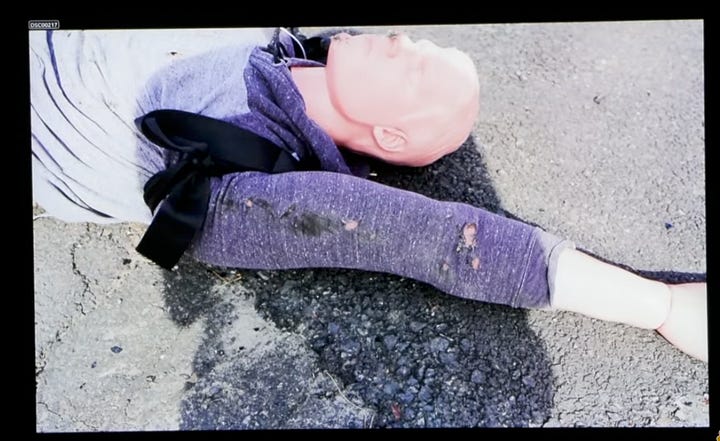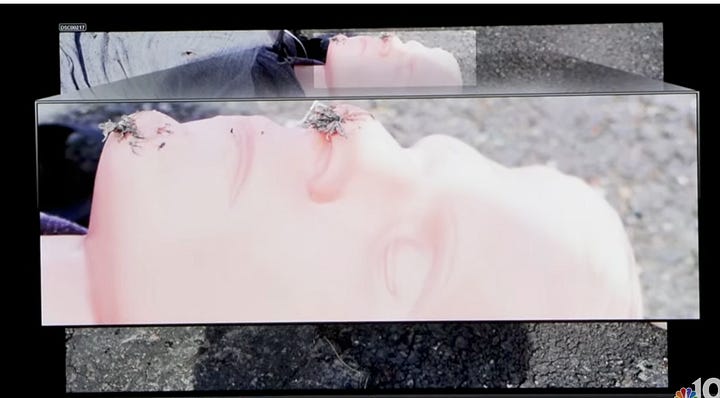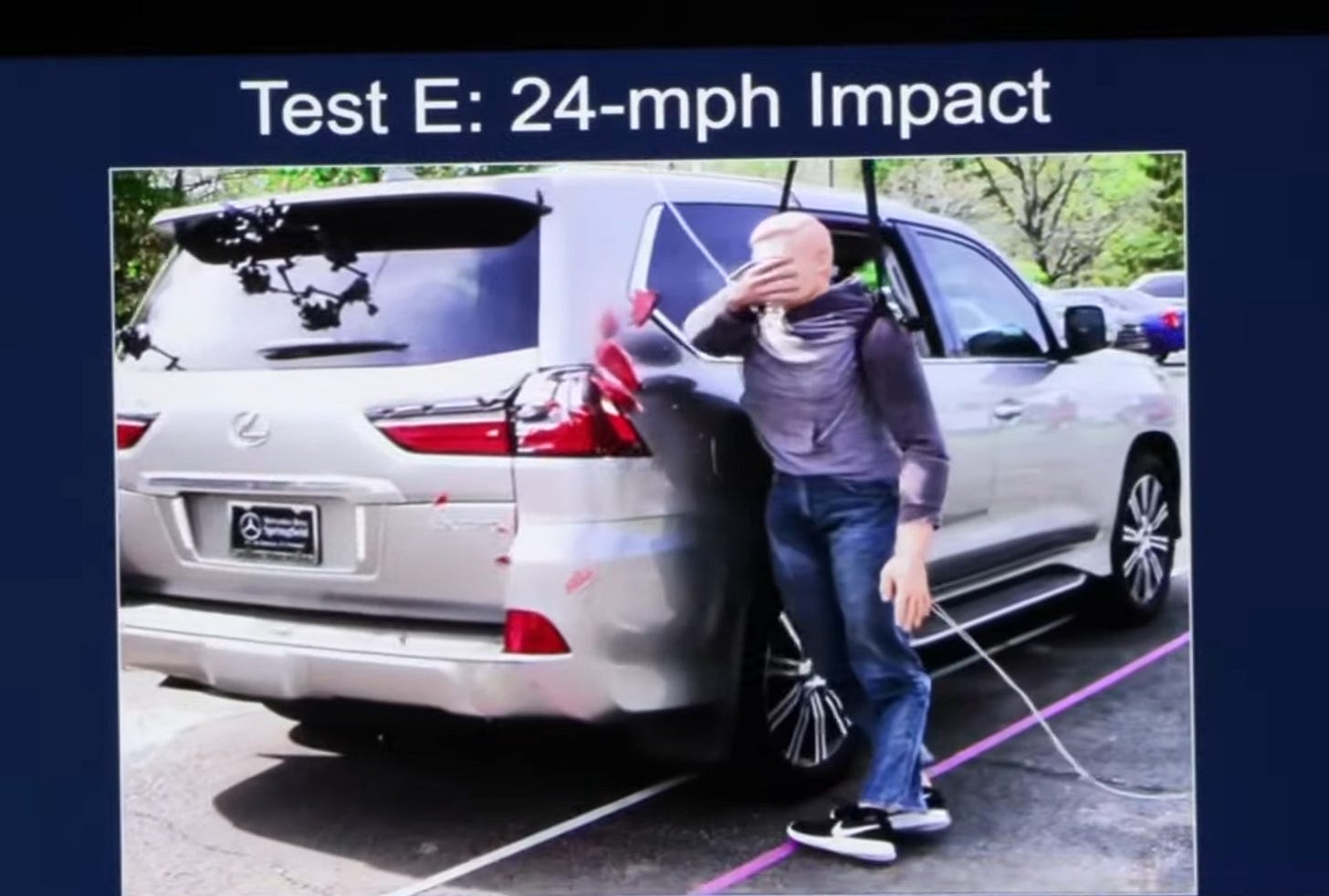DAY 29: Karen Read Retrial
Dummy Arms and Drama.
Well…
I was not expecting a Shakespearean performance in black latex gloves, but THIS is the Karen Read Trial so I should have been more geared up.
Here’s the recap. You’ll find the theatrics somewhere in the middle.
ON THE STAND TODAY:
Daniel Wolfe (Director of Accident Reconstruction at ARCCA)
John Tedeman (Private Investigator)
Dr. Elizabeth Laposata (Forensic Pathologist)
Daniel Wolfe (Director of Accident Reconstruction at ARCCA)
Testimony starts with Wolfe back on the stand under re-direct examination.
Defense Attorney Jackson puts photos up on the projector and asks Wolfe what defects he sees on the dummy doll that was hit by a reverse speed of 29 mph. Wolfe points out:
Holes on the left sleeve from road rash.
A large hole on the back right arm of sweatshirt from road rash.
Debris from pavement on sweatshirt
Dummy doll also has some chin and nose scuffs
Front of sweatshirt has holes and rips.
Shoes remained on feet.




Wolfe says the test doll did not show holes from the broken taillight on the right arm, and his opinion is that the doll’s clothing is inconsistent with John’s clothing.
Jackson has Wolfe do calculations regarding vehicle speed, weight of arm, and the energy it would transfer when impacted.
SUV reversing at 24 mph (arm weighs 11.86 lb) = 3415.68 energy transferred.
SUV reversing at 29 mph (arm weighs 9.38 lb) = 3,944.29 energy transferred.
RE-CROSS EXAMINATION:
Yesterday afternoon, while under redirect, Defense asks Wolfe where Prosecutor Brennan got the number 11.86 lbs as the general weight estimation for John’s arm. Wolfe said he didn’t know.
Today, Prosecutor Brennan asks Wolfe if he recalls telling the court in the first trial that John’s arm weight was about 11 lbs. He agrees that he said that. Wolfe then adds that he doesn’t understand where Brennan got the added .86.
Brennan asks if Wolfe - or anyone else - weighed John’s arm in isolation. Wolfe says he did not, and does not know if anyone else did.
Brennan suggests that Wolfe commonly has to use statistics of body mass in his field when things like limbs cannot be weighed in isolation. Wolfe says, “In some instances, yes.”
Prosecutor Brennan: “So when you are relying on body weight and different parts of the body, there is strong statistical studies that give you a guide. Isn't there?”
Wolfe: “I would agree with that.”
Brennan then asks Wolfe if John was statistically in the 95% range of
body weight/ height then why would he choose to use a dummy arm that fits the statistics of someone in the 50% range? There was a weighted dummy arm that was much closer to John’s statistical arm weight, so why did Wolfe opt for the one that weighed less when doing a test where weight is important?
Wolfe says they did a test with a faster reverse test (29 mph) to account for the difference in weight.
Brennan follows this up by asking if Wolfe intentionally chose the lighter dummy arm weight to manipulate the testing results regarding the damage to the vehicle. Wolfe says no.
Wolfe says he was not aware of the studies that say a crash test dummy should not be used to assess injury and clothing on an arm. Brennan points out that a human arm is softer and indents. The pull of fabric would need less force to rip than that of a hard dummy arm. Wolfe agrees.
The sweatshirts used in testing were new (unwashed), however Wolfe agrees he did not consider how well-worn (and washed) John’s actual sweatshirt was. He did not do any analysis or research on how that fabric changes (or weakens) after use.
Brennan brings the sweatshirt (in a plexiglass glass-type frame) and has Wolfe examine the back of it. Wolfe agrees that beyond the medical intervention cuts on the shirt, there are some small holes.
DRAMATIC INTERMISSION
After the court takes their regular morning 20 minute break, Defense Attorney Alessi puts evidence gloves on and theatrically demands a mistrial... AGAIN.
He claims that Prosecutor Brennan wrongly alleged that the holes in the back of John’s sweatshirt were from the vehicle accident when the criminologist’s report states the holes were made during her examination process.
Brennan is shown the report, and concedes he was mistaken.
Alessi continues demanding a mistrial claiming that there is no evidence of a collision.
(Insert gigantic eye roll here. We all saw plenty of evidence that points to a collision including ARCCA’s own collision video)
Judge denies a mistrial, and alerts the jury to disregard the sweatshirt holes as part of the accident.
INTERMISSION ENDS.
John Tedeman (Private Investigator)
Tedeman testified very briefly.
He measured the distance from the mailbox area to the doors located on the front side, exterior of the home. One measured at 65 ft 9 in, and another 70 ft 1 in.
On cross-examination, Brennan asked him if he measured distances from the actual flag pole area to the home (walking up the driveway) and Tedeman says yes, but he doesn’t have that measurement on him. Agrees it’s over 80 feet.
Dr. Elizabeth Laposata (Forensic Pathologist)
Dr Laposata served as Chief Medical Examiner for Rhode Island. Currently runs her own independent consulting practice, and she’s an Associate Professor at Brown University of Medicine. Teaches classes on diseases of the heart. She has done lectures on toxicology and forensic pathology.
Laposata shares several high-profile tragic events she was involved with as a Medical Examiner. One is the Egypt Air plane crash in ‘99 and the other was the Station Nightclub fire.
Laposata discusses how John’s back head wound caused his black eyes. Says they were not from a direct hit to the eyes.
Defense asks if the laceration right above the eye could be caused by a fist. She says it could.
Laposata says John’s head wound was caused by falling backward and hitting his head. She says his head did not hit a flat surface but some irregular ridge.
Court ended for the day while she was on direct examination.









Thank you Tuesday. Homestretch. :)